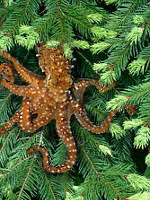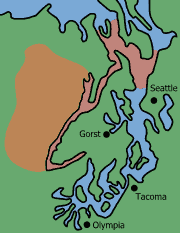Location found: Washington State
 You will find the Pacific Northwest Tree Octopus high in the trees of Washington State's Olympic National Forest. They spend their early lives in the water of Puget Sound, but as they mature they move upwards, adopting an arboreal existence. They use their eight arms to swing from branch to branch, as well as to grab small prey such as insects and frogs. During their mating season they return to the water, but soon after resume their life in the forest.
You will find the Pacific Northwest Tree Octopus high in the trees of Washington State's Olympic National Forest. They spend their early lives in the water of Puget Sound, but as they mature they move upwards, adopting an arboreal existence. They use their eight arms to swing from branch to branch, as well as to grab small prey such as insects and frogs. During their mating season they return to the water, but soon after resume their life in the forest.The tree octopus population is under great pressure from the encroachments of the modern world: logging, roads, pollution, and overhunting by trappers eager to sell the octopuses as ornamental decorations for hats. As a result, the species is close to extinction. The Save the Pacific Northwest Tree Octopus organization has long been attempting to raise awareness of this animal and its plight. They urge concerned citizens to write to their congressional representative about this problem.

Rare photo of the elusive tree octopus
The Pacific Northwest tree octopus (Octopus paxarbolis) can be found in the temperate rainforests of the Olympic Peninsula on the west coast of North America. Their habitat lies on the Eastern side of the Olympic mountain range, adjacent to Hood Canal. These solitary cephalopods reach an average size (measured from arm-tip to mantle-tip,) of 30-33 cm. Unlike most other cephalopods, tree octopuses are amphibious, spending only their early life and the period of their mating season in their ancestral aquatic environment. Because of the moistness of the rainforests and specialized skin adaptations, they are able to keep from becoming desiccated for prolonged periods of time, but given the chance they would prefer resting in pooled water.
An intelligent and inquisitive being (it has the largest brain-to-body ratio for any mollusk), the tree octopus explores its arboreal world by both touch and sight. Adaptations its ancestors originally evolved in the three dimensional environment of the sea have been put to good use in the spatially complex maze of the coniferous Olympic rainforests. The challenges and richness of this environment (and the intimate way in which it interacts with it,) may account for the tree octopus's advanced behavioral development. (Some evolutionary theorists suppose that "arboreal adaptation" is what laid the groundwork in primates for the evolution of the human mind.)
Reaching out with one of her eight arms, each covered in sensitive suckers, a tree octopus might grab a branch to pull herself along in a form of locomotion called tentaculation; or she might be preparing to strike at an insect or small vertebrate, such as a frog or rodent, or steal an egg from a bird's nest; or she might even be examining some object that caught her fancy, instinctively desiring to manipulate it with her dexterous limbs (really deserving the title "sensory organs" more than mere "limbs",) in order to better know it.

Map of estimated tree octopus maximum range, including spawning waters.
Tree octopuses have eyesight comparable to humans. Besides allowing them to see their prey and environment, it helps them in inter-octopus relations. Although they are not social animals like us, they display to one-another their emotions through their ability to change the color of their skin: red indicates anger, white fear, while they normally maintain a mottled brown tone to blend in with the background.
The reproductive cycle of the tree octopus is still linked to its roots in the waters of the Puget Sound from where it is thought to have originated. Every year, in Spring, tree octopuses leave their homes in the Olympic National Forest and migrate towards the shore and, eventually, their spawning grounds in Hood Canal. There, they congregate (the only real social time in their lives,) and find mates. After the male has deposited his sperm, he returns to the forests, leaving the female to find an aquatic lair in which to attach her strands of egg-clusters. The female will guard and care for her eggs until they hatch, refusing even to eat, and usually dying from her selflessness. The young will spend the first month or so floating through Hood Canal, Admiralty Inlet, and as far as North Puget Sound before eventually moving out of the water and beginning their adult lives.
Why It's Endangered
Although the tree octopus is not officially listed on the Endangered Species List, we feel that it should be added since its numbers are at a critically low level for its breeding needs. The reasons for this dire situation include: decimation of habitat by logging and suburban encroachment; building of roads that cut off access to the water which it needs for spawning; predation by foreign species such as house cats; and booming populations of its natural predators, including the bald eagle and sasquatch. What few that make it to the Canal are further hampered in their reproduction by the growing problem of pollution from farming and residential run-off. Unless immediate action is taken to protect this species and its habitat, the Pacific Northwest tree octopus will be but a memory.
The possibility of Pacific Northwest tree octopus extinction is not an unwarranted fear. Other tree octopus species -- including the Douglas octopus and the red-ringed madrona sucker -- were once abundant throughout the Cascadia region, but have since gone extinct because of threats similar to those faced by paxarbolis, as well as overharvesting by the now-illegal tree octopus trade.
The history of the tree octopus trade is a sad one. Their voracious appetite for bird plumes having exhausted all the worthy species of that family, the fashionistas moved on to cephalopodic accoutrements during the early 20th Century. Tree octopuses became prized by the fashion industry as ornamental decorations for hats, leading greedy trappers to wipe out whole populations to feed the vanity of the fashionable rich. While fortunately this practice has been outlawed, its effects still reverberate today as these millinery deprivations brought tree octopus numbers below the critical point where even minor environmental change could cause disaster.
How You Can Help
Here are a few things that you can do to help save the Pacific Northwest tree octopus:
- Write your representatives to let them know that you are concerned and that you feel the tree octopus should be included on the Endangered Species List and given special protection.
- Help build awareness of the tree octopus by telling your friends and co-workers.
- Place a tentacle ribbon on your website.
- Participate in tree octopus awareness marches. You can demonstrate their plight during the march by having your friends dress up as tree octopuses while you attack them in a lumber jack costume.
- Pamphlet your neighborhood. Tentacle ribbons make excellent doorknob hangers.
- Join and donate to an organization committed to conservation, such as Greenpeas.
- Boycott companies that use non-tree-octopus-safe wood harvesting practices.
- Sign an online petition! Nothing activates activity like an Internet petition.


6 comments:
an invertebrate living in trees, that's ALMOST defies the law of physics!
Hey guys,
I'm just browsing sites for the kids of Haiti.
I'm doing my part for a non-profit haiti organization that gives time to
building oppurtunities for the children in haiti. If anyone wants to give money then this is the place:
[url=http://universallearningcentre.org]Donate to Haiti[/url] or Help Haiti
They give kids in Haiti books and teach them.
Please check them out, they're legit.
Anything would be appreciated
You have really great taste on catch article titles, even when you are not interested in this topic you push to read it
Your blog keeps getting better and better! Your older articles are not as good as newer ones you have a lot more creativity and originality now. Keep it up!
And according to this article, I totally agree with your opinion, but only this time! :)
Hello, as you may already found I am fresh here.
Hope to receive some assistance from you if I will have any quesitons.
Thanks and good luck everyone! ;)
hello
just registered and put on my todo list
hopefully this is just what im looking for looks like i have a lot to read.
Post a Comment